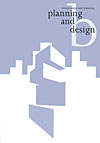The infrastructure of experience and the experience of infrastructure
The paper was published in the latest issue of Planning and Design – a theme issue on “space, sociality, and pervasive computing“.
Abstract
Although the current developments in ubiquitous and pervasive computing are driven largely by technological opportunities, they have radical implications not just for technology design but also for the ways in which we experience and interact with computation. In particular, the move of computation `off the desktop’ and into the world, whether embedded in the environment around us or carried or worn on our bodies, suggests that computation is beginning to manifest itself in new ways as an aspect of the everyday environment.
One particularly interesting issue in this transformation is the move from a concern with virtual spaces to a concern with physical ones. Basically, once computation moves off the desktop, computer science suddenly has to be concerned with where it might have gone. Whereas computer science and human – computer interaction have previously been concerned with disembodied cognition, they must now look more directly at embodied action and bodily encounters between people and technology.
In this paper, we explore some of the implications of the development of ubiquitous computing for encounters with space. We look on space here as infrastructure—not just a technological infrastructure, but an infrastructure through which we experience the world. Drawing on studies of both the practical organization of space and the cultural organization of space, we begin to explore the ways in which ubiquitous computing may condition, and be conditioned by, the social organization of everyday space.
I am also quoting one synthesising paragraph from halfway into the paper:
What we are suggesting then is an alternative model of space and spatiality than that which dominates current discourse in the design of pervasive-computing technologies and environments. Pervasive computing brings computation out of the traditional desktop and into the spaces beyond; but the critical feature of these spaces is that they are always already populated and inhabited. More to the point, the experience of space is the experience of multiple infrastructures — infrastructures of naming, of movement, of interaction, etc — and these infrastructures emerge from and are sustained by the embodied practices of the people who populate and inhabit the spaces in question. Spaces are not neutral, and their complex interpretive structure will frame the encounter with pervasive computing; as, by the same token, the opportunities afforded by new technologies allow for a reinterpretation and reencounter with the meaning of space for its inhabitants. Fundamentally, the experience of space is coextensive with the cultural practice of everyday life.
I highly recommend reading this paper, although quite conceptual at times , and to savour their thoughts on for instance the importance of ‘seamful’ design (as opposed to seamless computing), “allowing technologies to make boundaries and seams visible”.
(Last year, Bell and Dourish wrote another very good paper together which provided a people-centred critique of the current ubiquitous computing paradigm.)
Download paper (pdf, 173 kb, 18 pages)
(via Peter Dalsgaard)





[…] The infrastructure of experience and the experience of infrastructure [found at putting people first] […]
[…] in Denmark. The ideas behind it seem similar to concepts developed by both Genevieve Bell (see here and here) and Adam […]
[…] The infrastructure of experience and the experience of infrastructure [from Putting People First] […]
[…] the sense given it by Paul Dourish and Genevieve Bell in their essay on pervasive computing titled “The Infrastructure of Experience and the Experience of Infrastructure: Meaning and Structure in E… For Bell and Dourish, infrastructures describe the ways in which we encounter spaces, not only […]
[…] the sense given it by Paul Dourish and Genevieve Bell in their essay on pervasive computing titled “The Infrastructure of Experience and the Experience of Infrastructure: Meaning and Structure in Ev… For Bell and Dourish, infrastructures describe the ways in which we encounter spaces, not only […]